Mon 19 Apr 2010
THE STRANGER. RKO Radio Pictures, 1946. Edward G. Robinson, Loretta Young, Orson Welles, Philip Merivale, Richard Long, Billy House. Screenplay: Anthony Veiller. Director: Orson Welles.
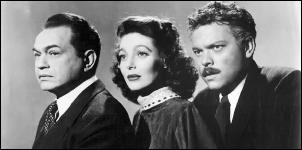
The dark nature of this movie of course is what consigns it to the noir category, that plus the moody but still dazzling black-and-white photography, complete with unusual camera angles, especially during the many trips up and down the inside of the bell tower facing the green in a small one-horse town in Connecticut right after the war.
But is it really a noir film? Not really by subject matter, that of a post-World War II manhunt. A former top member of Nazi party in Germany (Orson Welles) who by posing as a history teacher at a local academy, has somehow managed to infiltrate his way into local society so solidly enough that he is about to marry the daughter (Loretta Young) of a US Supreme Court justice who lives in town.
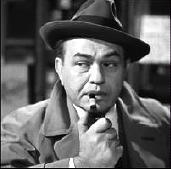
On his trail is one man, a representative of the US government known only as Mr. Wilson (Edward G. Robinson). His problem? He does not know the face of the man he is after, a world-class criminal who managed to keep his identity a secret while the Nazis were in power, a man with vicious ideas who preferred to do his nasty work behind the scenes only.
The noirish concept of an innocent man in over his head through his own weakness and/or the sheer vicissitudes of fate do not apply here. Professor Charles Rankin, as he is known now, is a bad man, and as a killer who senses he is about to be trapped, he needs to be caught. It is only the camera work and Welles’ direction that makes this movie qualify as noir, and then by only the slimmest of margins.
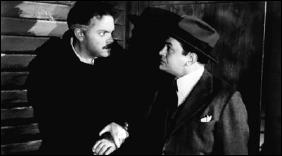
Edward G. Robinson is as earnest as only Edgar G. Robinson could be, and Loretta Young I do not believe could look only lovelier. It is her predicament that is the most heartbreaking. In love with a man who is a monster, she cannot accept it, even as a mountain of facts begins to pile up against him.
As for fierce-looking Mr. Orson Welles himself, he is dark, brooding and sullen throughout the movie. It is difficult to believe that the cheerful Loretta Young could fall in love with such a man, much less go on a honeymoon with him.
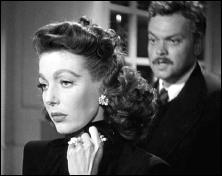
It is also hard to believe, that even in simpler times, the credentials and background of the man to whom the daughter of a Supreme Court justice is married would not have been checked more thoroughly earlier on. Before enjoying this movie to the fullest, we in this more cynical age must accept that life (and politics) were easier then.
Otherwise this well-meaning movie, the first to show footage of concentration camps in Germany, or so I am told, is only a well-designed and well-produced relic of the past, a magnificent artifact caught up in amber and preserved for us today, a different time altogether.
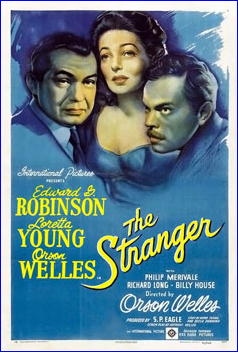
April 20th, 2010 at 1:02 am
First I don’t find this one quite as unlikely as you do because of the number of Nazi war criminals who have been found living in this country over the years. Admittedly they weren’t as big a fish as Welles character and didn’t marry the daughter of a Supreme Court justice, but that may be something you have to give the film. There was a concentrated effort by many in the Nazi hierarchy to escape their crimes near the wars end and a large organization designed to aide them (known as Odessa). This is only a little more unlikely than it seems if you know some of the true stories.
The monster next door is a common noir theme. As for the film’s other noir aspect that isn’t in Welles character, but Robinson’s. The seemingly gentle Robinson proves to be ruthless, cruel, and obsessive in his hunt for Welles, endangering Loretta Young and her brother (Richard Long)and using a Nazi associate of Welles as a staked goat sacrificed to Welles tiger without so much as a single regret. For all his quiet charm Robinson’s Wilson has been twisted by the dragon he hopes to slay.
The small New England town setting is mindful of another unlikely noir classic — albeit on the West Coast, Hitchcock’s SHADOW OF A DOUBT which also has a less than innocent man being hunted and an innocent young woman who doesn’t want to believe the truth. That one is even sunnier and less noirish than THE STRANGER, yet an acknowledged classic of the genre.
Noir isn’t always set in the mean streets and dark alleys haunted by private eyes and desperate loners. Sometimes its set in sunny climes among ordinary people who find the darkness hiding where no one expects it.
April 20th, 2010 at 12:38 pm
David
It wasn’t that a Nazi war criminal was found living in the US that was a problem for me. If Rankin had married the daughter of a local or state judge, I’d have had no problem with that.
But the daughter of a Supreme Court justice? That’s when the stakes were raised too high, at least for me and I grant you, maybe nobody else.
Nor did I find Robinson, as the Nazi hunter, as ruthless and cruel as you, but it’s an interesting perspective, and I’ll remember it the next time I watch the movie. Dedicated, and as I said, earnest, with a dash of ruthlessness, yes, but cruel? I’ll have to watch the movie again.
While watching the movie this time, I’d have said he was inept rather than twisted. I wondered, for example, what took him so long to pin the Nazi collar on his prey. That single bit of conversation with Rankin that woke him up later on, in the middle of the night, roused all kinds of warning flags to me, as soon as he (Rankin) said it.
There’s no question that noir films can take place in the sunniest of days. In fact, the contrast might even make the darkness in a character’s mind all the more bleak, when confronted with sunshine and happiness on the faces of others, even if that’s also only a facade.
On a noir scale of 0 to 100, I’d tentatively rank STRANGER as a 65, based largely on the film-making techniques, and not so much on the story.
But that’s subject to revision, as I said above. I’ll watch the movie again, perhaps even soon, and when I do so, I’ll make sure to take a good look at Edward G. Robinson as Mr. Wilson, and not so much (as I did this time) at Orson Welles, his prey.
— Steve
April 20th, 2010 at 1:49 pm
I recently saw some interviews with Welles, and he had something to say about THE STRANGER. It seems that his original intention was to have Agnes Moorehead rather than Robinson as Rankin’s Nemesis. She would have been a snoopy town gossip turned amateur investigator (a Marple or Withers type)who would gradually uncover the truth about him. The studio quashed the idea, which is a shame as it might have been fun.
Welles noticed Robinson was unhappy for the first few days of shooting, and eventually took him to one side and asked him what was wrong. Robinson told him that he was being filmed on the wrong side. The unflattering side of his face was constantly toward the lens. Welles was flabbergasted. As he told the interviewer: Robinson was a terrific actor, but who ever thought that his face HAD a good side?
April 20th, 2010 at 9:33 pm
Steve
Next time you watch this take particular note of Robinson’s face when he shows Loretta Young the films of the Holocaust. And stop and think about the plot. He puts her life in danger — admittedly a plot point — but needlessly, since by any standard he has enough evidence to start a case against Welles. He isn’t after justice, but revenge.
I think his character falls within the old Nietzschean line of he who fights the dragon becomes the dragon. That his character is depicted as folksy and gentle makes a nice contrast to how ruthless he really is. And too, we are both ignoring the noir aspects of Loretta Young’s character — the innocent confronted by unimaginable evil in her own bedroom and developing the steel needed to destroy that evil.
By the film’s finale, she, not Robinson, has become Nemesis.
And I’ve always thought in many ways the film develops as a horror movie as much as suspense film. Welles character might as well be a vampire as a Nazi, and Robinson Van Helsing.
Bradstreet
Robinson had a good side? Who knew?
April 20th, 2010 at 10:21 pm
David
You’re right about Loretta Young and the character she plays. I mentioned her in my review, but happens to her is far worse than a mere “predicament.” For her, a world-shattering catastrophe is more like it.
She at first refuses to believe the facts Wilson presents her against her husband, then gradually forces herself to start accepting the fact that he is indeed who Wilson says he is.
You’re right. If this is not a noir situation, nothing is.
As for Wilson, you make some good points, but I’m still not quite convinced. But where I referred to him as “inept” in my earlier comment, I’ve largely changed my mind on that. Until I watch the movie again, I’m thinking now that his actions are more plot contrivances than anything else.
I will accept the use of the word “obsessed” to describe him, but not yet “ruthless,” assuming that there’s a difference.
— Steve
April 21st, 2010 at 12:08 am
Steve
Don’t worry, I’m not trying to convert you or pervert myself as Joyce says, just arguing a point. We are likely both right from our point of view, and that may be a compliment to a fairly subtle performance by Robinson that is open to interpretation by the viewer.
But I think some of what seems to be plot contrivance can also be interpreted by the fact Wilson isn’t content just to capture Welles character — he wants to slay the beast, and that requires a different kind of evidence than merely arresting him. That requires putting Young and her family in danger and forcing Welles hand.
Of course it’s also possible neither Welles nor screenwriter Anthony Vellier knew just how little hard evidence it would have required to arrest Welles under the circumstances. Movies and television always make us think the police always have cast iron cases before an arrest and prosecution, and it just isn’t so. Not only will a grand jury indict a ham sandwich, in some cases they have. Many a man sits in prison, rightly or wrongly, convicted on evidence that wouldn’t pass muster on an episode of MURDER SHE WROTE.
And going back to that marriage to a Supreme Court Justice’s daughter, there have been fairly famous cases in recent years of high profile con men posing as members of the Rockeller family or as Sidney Poitier’s son among the very rich and famous and getting away with it until their ego became too big. Merle Oberon sold that silly story of her royal birth for years when she was really Merle O’Brien. Restauranter Nicky Romanov posed as Russian royalty for most of his lifetime. Alister Crowley was accepted in the highest of society and rubbed shoulders with the literary elite. One of his acolytes worked on the Manhattan Project.
You can fool some of the people some of the time … At the end of WW II it wasn’t as if the FBI would have run a background check on the fiance of a Court justice unless he was suspected of Red sympathies, and keep in mind we were busy erasing the evidence of many Nazi’s we thought might be useful to us in the fight against the Russians. Nor would the son in law of a Court justice have gotten much exposure other than a few wedding photos. Outside of Washington his face would be seen in a handful of fuzzy black and white photos in newspapers and magazines and maybe a newsreel or two.
I’m not really sure anyone would pay that much attention to who a Supreme Court Justice’s daughter married at the time — I had a much harder time buying how easily Welles adapted and sounded like an American than I did that aspect. But, after all, for much of the war the Brit’s passed a Corporal off as General Montgomery — sometimes even to Allied generals. Stranger things have happened. Napoleon’s double was so good some argue it was he who died on St. Helena. People see what they want and expect to see, and only in fiction do we have to make it probable or plausible.
Truth can be much stranger than fiction.
Winston Churchill so feared many Nazi war criminals would escape detection and punishment in the confusion and political expediency of the post war era, that he created a special commando unit (members included spies Dusko Popov and Juan Madrid and spy novelist Desmond Cory) who hunted down and executed war criminals in the final days of the fighting — the origin of Ian Fleming’s Double O section. The world may have been made of glass for them, but it took twenty years to catch Eichmann and we never did get Bormann or Mengele outside of fiction. The awful truth is just how much more plausible THE STRANGER is in light of what we know now, than what was known then.
April 21st, 2010 at 1:17 am
Points all well taken!
April 21st, 2010 at 3:24 pm
Uh, Steve old pal, not that it really matters, but…
EDGAR G. Robinson?
All through the entry, and even in the comment replies?
Guess your mind was somewhere else.
Because as we all know, he’s really Emanuel Goldenberg.
I kid because I care.
April 21st, 2010 at 4:22 pm
Mike
Edgar? Egad! I wonder where that came from. J. Edgar Hoover, maybe??
In case, I think I’ve repaired all the errors, even in the comments. I hope I didn’t miss any.
PS. How come, Mike, you were the first to notice? I think it’s everybody else who has to crank it up. Thanks!
David
After due consideration, I’ve upgraded the movie’s Noir Factor to 85. If it changes again, it can only go higher.
— Steve